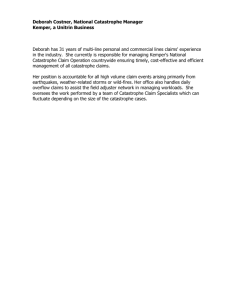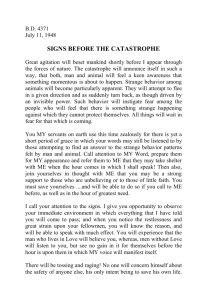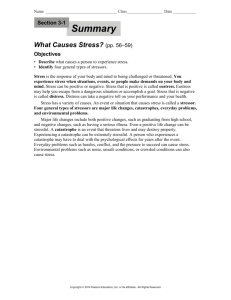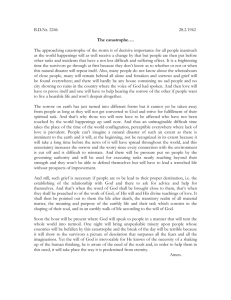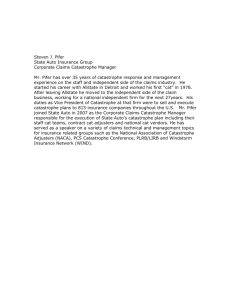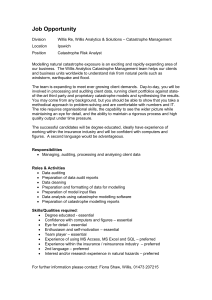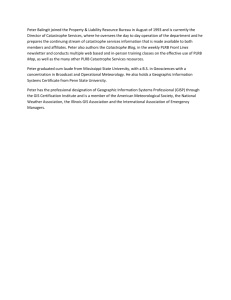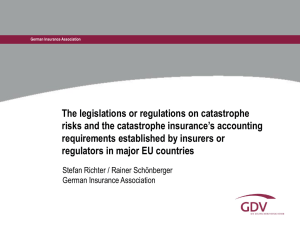Catastrophe Preparedness ppt iaem Bissell
advertisement
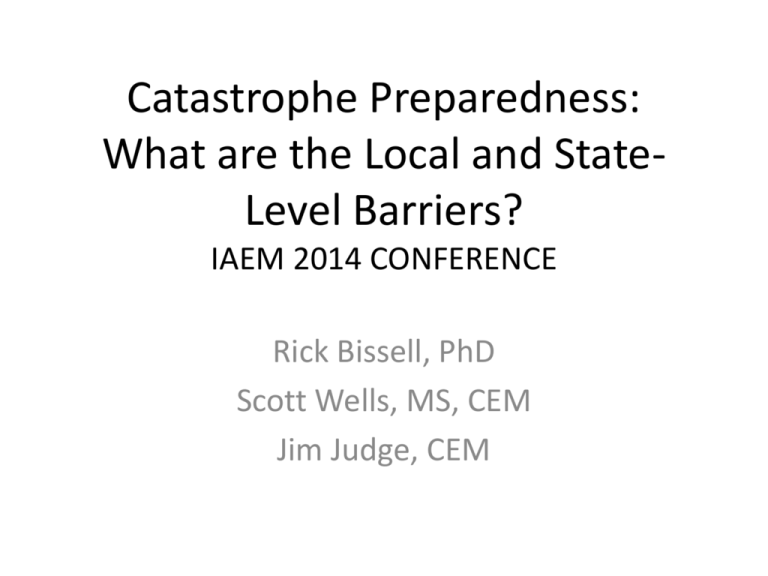
Catastrophe Preparedness: What are the Local and StateLevel Barriers? IAEM 2014 CONFERENCE Rick Bissell, PhD Scott Wells, MS, CEM Jim Judge, CEM Objectives • Define and describe catastrophe • Describe research findings • Describe and assess federal catastrophe readiness • Discuss importance of local self-sufficiency • Discuss barriers to state and local prep for catastrophes • Describe several “successful” programs Catastrophe Definition • A catastrophe is an extreme event that overwhelms the nation’s ability to respond effectively using its own resources. – Could be rapid or slow onset – Outside assistance needed – Internal and external sequelae – Hypercomplex Complications/Challenges • • • • • • • Too large for any one entity to control Many jurisdictions and levels Complex dynamics/interactions Hard-to-predict decision impacts Demands exceed supply Massive local isolation Local knowledge but distant resources Complications/Challenges - 2 • Vastly insufficient # of responders • Responders and law enforcement among victims • Long wait for outside resources • Competition for scarce resources • Lack of household self-sufficiency • Conventional response mechanisms are not sufficient Complications/Challenges - 3 • • • • Outmigration & those left behind Mass resettlement Lack of international agreements Media coverage can impact response operations • NIMS compliance Federal Efforts & Changes • Scenario-based explorations to examine needs – Mega earthquake, i.e. New Madrid – Mega hurricane, S. Florida – Improvised nuclear device – Pandemic • Move to capability-based planning and prep • “Whole Community” concept • Focus on volunteers and private sector Federal Efforts and Changes - 2 • Integrated Planning program – 15 planning scenarios – To-down approach • Catastrophic Planning Program – Bottom-up in New Madrid Seismic Zone – South Florida • PPD-8 Hypercomplexity Approach • Modern society is hypercomplex with myriad linkages and interdependencies • Private business and science may better understand linkages and interdependencies better than emergency managers • Thorough use of non-government actors in planning and implementation • Rapid reflection force Conundra • Local level has most knowledge of needs, the affected environment, and responsibility for direct services • Has least access to: – Resources – Big picture – Trained logisticians and communications experts – Ability to re-direct resource flows Conundra - 2 • Federal government has access to resources and expertise, but – Unity of effort is difficult to achieve on a national scale (Authorities are shared among all levels of government) – Often has little understanding of local needs or capabilities – Has performance responsibilities but insufficient personnel Conundra - 3 Federal, continued • Habit of legalistic rather than outcomes-based decisions • Not a primary mission for virtually all federal departments Barriers – State Level Planning • • • • Small states have limited resources Erroneous belief in self-sufficiency Erroneous belief in “manna from Heaven” Conflicting/changing federal plans/programs/requirements • Lack of experience/high turnover • Filling potholes is more important than writing emergency plans Barriers – State Implementation • Thin resources • Little control over crucial assets – Federal highways – Airports – International border crossings – Communications allocations – Interstate waterways Barriers – City/County Planning • Lack of resources/expertise • Belief in “manna from state” • Conflicting state/federal regulations, priorities, and funding requirements Barriers- City/County Implementation • Resources quickly overwhelmed • Failure to see citizens as resources • Thinly spread human resources – Rapid expansion very difficult • Limited domain over crucial resources Avenues to Explore • Greater incorporation of – PVOs, churches, universities, private business – Health care sector at all levels – Multi-jurisdictional planning committees – Response and recovery planning – Family and business preparedness programs – Neighborhood block programs – Technology advances (i.e. GIS) Avenues to Explore - 2 • Formation of local/state science/tech rapid advice panel • Development of citizen response groups – Citizen Corps – Maryland Responds • Development of methods and plans for incorporating spontaneous volunteers Avenues to Explore - 3 • Review/revise liability laws re volunteers • New doctrine Vignette of a Successful County • County to be selected by Jim Judge Open Discussion • How can we improve our ability to help our populations survive and recover from catastrophic disasters? • How can we integrate “catastrophe thinking” into routine planning, training, equipping and testing activities? Open Discussion - 2 • Are we being too critical? Should expectations be lowered? • How can we reduce the feeling that we’re all alone in this process? Thank you! • Rick Bissell, PhD Bissell@umbc.edu • Scott Wells, MS, CEM ascottwells@gmail.com • Jim Judge, CEM jjudge@volusia.org
